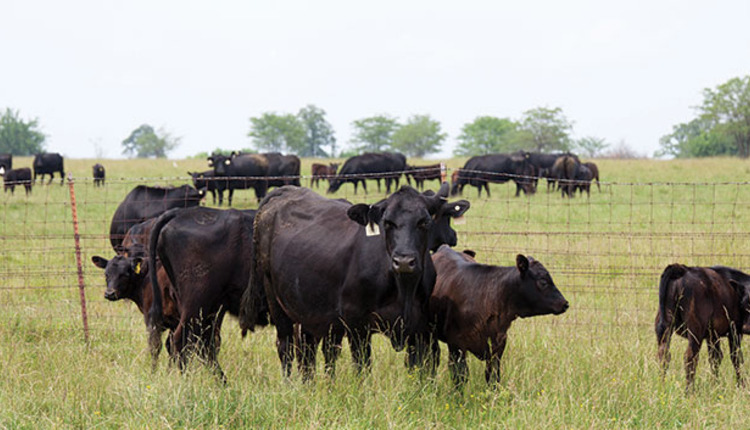How many cows? |
| By Jason Banta |
|
|
The author is a beef cattle specialist for Texas A&M AgriLife Extension based in Overton, Texas.  The title is a common question that I get when discussing the management of a property or when a producer considers buying or leasing a new property. Determining the best stocking rate for a farm or ranch is critical to its financial success and for good environmental stewardship. One of the first things that should be done is to determine the number of grazeable acres. This number can be significantly lower than the total number of acres because of woods, roads, ponds, lakes, barns, houses, and other land uses that prevent forage production and grazing. For example, a few years ago when oil exploration expanded, I know of one operation that lost 25 percent of their grazeable acres due to new roads and drilling pads. In just a short time, this greatly changed the number of cows that could be stocked on the ranch. The USDA’s Web Soil Survey is one tool that can be used to help determine grazeable acres. By using the area of interest feature, it will let you measure the size of pastures as well as wooded areas and ponds. For planning and discussion purposes, let’s assume that on average during a year a cow will consume about 2.25 percent of its body weight per day. Actual consumption will vary depending on stage of production, forage quality, weather conditions, and animal genetics. A 1,200-pound cow would consume about 9,855 pounds of forage per year (1,200 pounds x 2.25 percent x 365 days = 9,855 pounds). Research data is limited on forage intake of nursing calves, but we know the calf is consuming forage and the amount will increase as it gets older. For this example, 1,810 pounds of forage for the calf from birth through weaning and then 45 days of preconditioning will be used. This means the cow-calf pair would consume about 11,655 pounds of forage during the year. Available forage Forage production per acre and appropriate utilization rates are the next factors to consider when determining stocking rates. Forage production per acre is influenced by many factors; we will look at those later. For this example, 6,000 pounds of forage produced per acre will be used. The forage base and how much forage needs to be left to maintain a healthy productive stand must also be considered. Introduced forages like bermudagrass and bahiagrass can be utilized at much higher rates than native range forages. If we assume an introduced forage and allow the cows to consume 70 percent of the forage produced, then each acre could provide 4,200 pounds of forage for consumption (6,000 pounds x 70 percent = 4,200 pounds). The final step is to divide the amount of forage needed for the pair by the amount of forage that is consumed per acre. In this example, the 1,200-pound cow and its calf would need 2.8 acres (11,655 pounds of forage needed per pair ÷ by 4,200 pounds of forage consumed per acre = 2.8 acres per cow-calf pair). As you might expect, cow size has a huge impact on stocking rate. Using the assumptions from above, a 1,000-pound cow and its calf would need 2.3 acres, and a 1,400-pound cow and its calf would need 3.3 acres. Because cows are now larger, many properties become overstocked when they try to run the same number of cows as previous generations. When considering how many “cows” the property will run, don’t forgot to include land for bulls, replacement heifers, and any calves held past the 45- to 60-day preconditioning period. Many factors involved Forage production per acre is influenced by several factors, including rainfall, length of the growing season, soil type, forage species, and soil fertility. Soil type is often overlooked when evaluating a property. For most properties, the Web Soil Survey can be used to identify soil types and their relative production potential. Stocking strategies will vary based on operational goals, management style, and risk tolerance. Two main approaches can be taken. An aggressive stocking rate will allow for the opportunity to run more cattle on a given property. However, any time conditions are not optimal, additional feed resources must be purchased or herd numbers reduced. Another approach is to stock more conservatively at a level below the property’s average carrying capacity. This approach provides some insurance against drought and other adverse weather conditions. In most situations, it results in greater plant health, animal performance, and financial success for the operation. In most years, this approach allows the operator to manage extra forage, instead of trying to figure out how to deal with a lack of forage. This extra forage could be baled for hay and sold or stored for future use. It could also be used to retain ownership of calves through a stocker phase. It might allow for reduced fertilizer applications in some years. There is also nothing wrong with not grazing all forage that is grown; leaving extra forage can help thicken stands and reduce weed competition. Remember the best stocking rate is not a fixed number. It should be adjusted based on weather and This article appeared in the April/May 2018 issue of Hay & Forage Grower on page 22. Not a subscriber? Click to get the print magazine |
